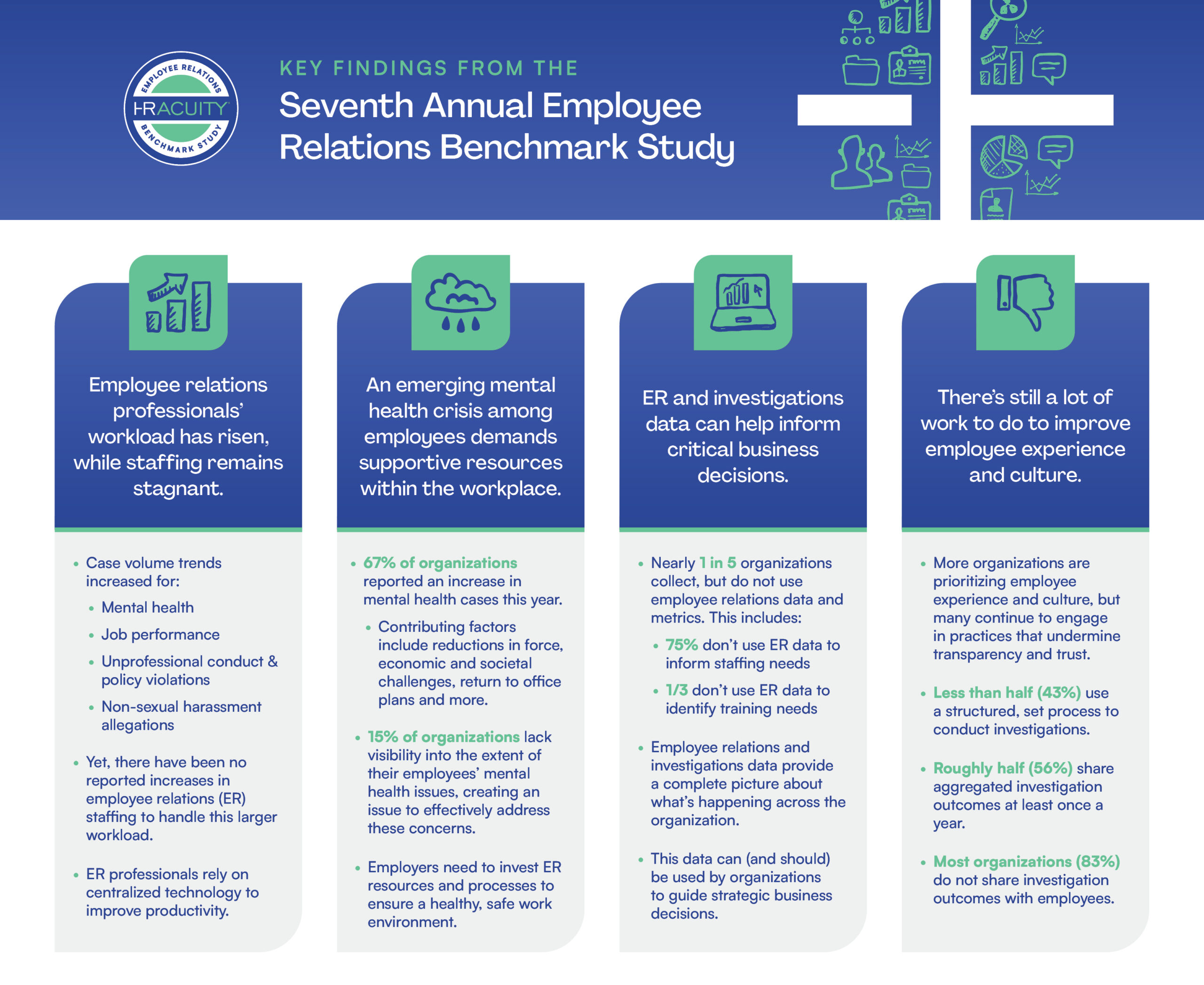What makes employee relations so invaluable to a business? Over the last few years, both employees and employers have faced many challenges and changes that were difficult to navigate. Through it all, human resources (HR) and employee relations (ER) professionals provided much needed assistance and support.
The unwavering and necessary dedication to employee satisfaction and a well-functioning organization has shown just how critical the employee relations function is for any organization. ER’s vast understanding of workplace culture, employee experience and well-being can help organizations enhance their HR procedures and initiate positive change.
But what are the leading trends in the workplace that demand ER and organizational attention? In this blog, we will dive into the latest four key findings identified in the Seventh Annual Employee Relations Benchmark Study.
1. Employee relations professionals face increasing case volumes, while staffing remains stagnant.
Over the past year, the volume of workplace issues has risen across various categories. Aside from mental health matters, the most significant increases occurred in accommodation requests, unprofessional conduct/policy violations and job performance issues. Union organizing and incidents of theft and fraud also increased.
In addition, non-sexual harassment allegations have been steadily rising since 2020. And sexual harassment and workplace bullying have returned to pre-pandemic levels in 2022, after growing at a slower rate during the prevalence of remote work in 2020.
But despite the growing cases, ER staffing ratios have remained unchanged. ER has had to step up to these increased caseloads to support their workplaces.
But how are they managing all this extra work? For one, dedicated employee relations technology helps enhance productivity by streamlining processes. By utilizing technology, organizations can better handle rising caseloads while achieving better outcomes for their employees and the organization.
2. Employees need support as mental health issues rise in the workplace.
This year, 67% of organizations reported an increase in workplace mental health cases. In fact, it was the most significant driver of increased employee relations case volumes in 2022. Multiple factors contribute to this, including reductions in force (RIFs), broader economic and societal challenges, higher performance expectations, return to office plans and more.
Yet, 15% of organizations lack visibility into the extent of their employees’ mental health issues. And the absence of this information can significantly impact an organization’s ability to effectively address and manage mental health concerns within its workforce. Therefore, it is crucial that businesses prioritize the documentation and tracking of employee issues to ensure a healthy and safe work environment.
To do this well, employers need to invest in reliable employee relations resources and technology. These necessary resources enable businesses to keep up with growing ER responsibilities – and keep track of issues in real-time to provide thoughtful, consistent aftercare.
See how a solution like HR Acuity can help you navigate employee relations and workplace issues. Click here to view a brief demo.
3. Employee relations and investigations data can help drive business decisions.
Businesses of all sizes utilize insights to make informed decisions across departments, whether related to headcount, technology or other resources. Employee relations is no different – and it deserves the same attention. However, this year’s report uncovered that nearly one in five organizations collect employee relations data and metrics, but do not use it to advise business decisions. This means companies are missing a critical opportunity to demonstrate the value of employee relations practices, which could lead to a better work environment, greater trust and additional resources.
For example, this data can help influence staffing decisions within employee relations. However, 75% of organizations are not using employee data to inform their staff needs. And as mentioned earlier in this blog, ER responsibilities have significantly grown over the last few years, while headcount has remained the same. Could this be due to a lack of visibility into the business requirements and supporting data within the ER role? This ER data can demonstrate the value of this expertise in an organization and help justify additional headcount, an important component of keeping pace with growing caseloads.
Furthermore, beyond assisting with headcount predictions, this information can help organizations predict and address company retention, staffing shortages, turnover, engagement and workplace culture. Once patterns are identified, organizations can make needed improvements and avoid similar problems in the future.
4. Many organizations are dedicated to employee experience and culture, but have work to do.
In recent years, companies have shown their dedication to listening to their employees and improving company culture. One way companies have demonstrated this is by implementing tools that capture employee feedback, issues and concerns.
In this year’s survey, nearly all (91%) of organizations reported that they have a tool that enables employees to anonymously report issues or concerns. This is a great start – and usually results in a higher, more accurate view into workplace issues.
However, companies can improve the feedback loop to build stronger relationships. Only 17% of organizations share investigation outcomes with employees – which can create barriers between employers and employees and lead to a belief that concerns are not taken seriously.
It is also concerning that only 45% of organizations use a structured process to conduct workplace investigations. Lacking investigative processes can result in serious implications and risks and make it difficult to build a culture of trust with employees.
Overall, understanding current ER trends can help set your business up for success and lead to a better, happier workplace. To learn more, click here to get the Seventh Annual Employee Relations Benchmark Study.





